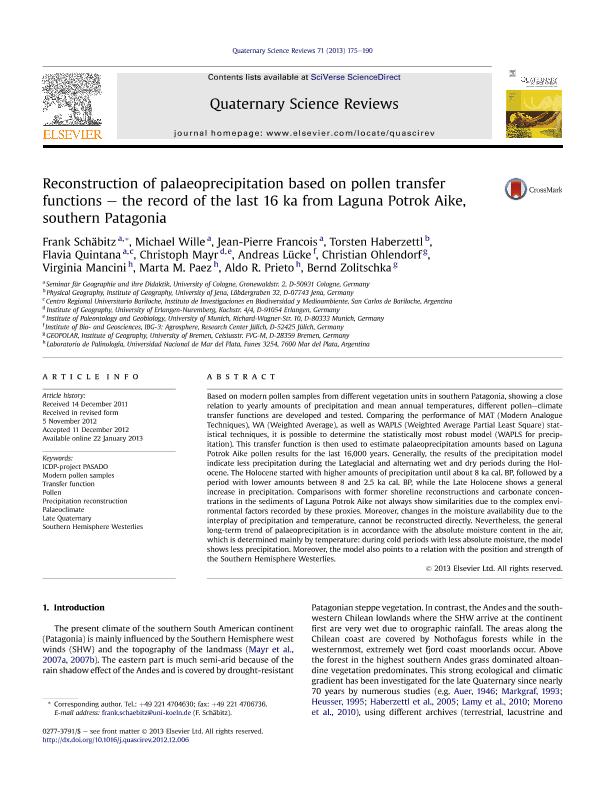Mostrar el registro sencillo del ítem
dc.contributor.author
Schäbitz, Frank
dc.contributor.author
Wille, Michael
dc.contributor.author
Francois, Jean-Pierre
dc.contributor.author
Haberzettl, Torsten
dc.contributor.author
Quintana, Flavia Andrea

dc.contributor.author
Mayr, Christoph
dc.contributor.author
Lücke, Andreas
dc.contributor.author
Ohlendorf, Christian
dc.contributor.author
Mancini, Virginia
dc.contributor.author
Paez, Marta M.

dc.contributor.author
Prieto, Aldo Raul

dc.contributor.author
Zolitschka, Bernd

dc.date.available
2017-10-05T19:29:15Z
dc.date.issued
2013-07-01
dc.identifier.citation
Schäbitz, Frank; Wille, Michael; Francois, Jean-Pierre; Haberzettl, Torsten; Quintana, Flavia Andrea; et al.; Reconstruction of palaeoprecipitation based on pollen transfer functions e the record of the last 16 ka from Laguna Potrok Aike, southern Patagonia; Pergamon-Elsevier Science Ltd.; Quaternary Science Reviews; 71; 1-7-2013; 175-190
dc.identifier.issn
0277-3791
dc.identifier.uri
http://hdl.handle.net/11336/26024
dc.description.abstract
Based on modern pollen samples from different vegetation units in southern Patagonia, showing a close relation to yearly amounts of precipitation and mean annual temperatures, different polleneclimate transfer functions are developed and tested. Comparing the performance of MAT (Modern Analogue Techniques), WA (Weighted Average), as well as WAPLS (Weighted Average Partial Least Square) statistical techniques, it is possible to determine the statistically most robust model (WAPLS for precipitation). This transfer function is then used to estimate palaeoprecipitation amounts based on Laguna Potrok Aike pollen results for the last 16,000 years. Generally, the results of the precipitation model indicate less precipitation during the Lateglacial and alternating wet and dry periods during the Holocene. The Holocene started with higher amounts of precipitation until about 8 ka cal. BP, followed by a period with lower amounts between 8 and 2.5 ka cal. BP, while the Late Holocene shows a general increase in precipitation. Comparisons with former shoreline reconstructions and carbonate concentrations in the sediments of Laguna Potrok Aike not always show similarities due to the complex environmental factors recorded by these proxies. Moreover, changes in the moisture availability due to the interplay of precipitation and temperature, cannot be reconstructed directly. Nevertheless, the general long-term trend of palaeoprecipitation is in accordance with the absolute moisture content in the air, which is determined mainly by temperature: during cold periods with less absolute moisture, the model shows less precipitation. Moreover, the model also points to a relation with the position and strength of the Southern Hemisphere Westerlies.
dc.format
application/pdf
dc.language.iso
eng
dc.publisher
Pergamon-Elsevier Science Ltd.

dc.rights
info:eu-repo/semantics/openAccess
dc.rights.uri
https://creativecommons.org/licenses/by-nc-sa/2.5/ar/
dc.subject
Icdp-Project Pasado
dc.subject
Modern Pollen Samples
dc.subject
Transfer Function
dc.subject
Pollen
dc.subject
Precipitation Reconstruction
dc.subject
Palaeoclimate
dc.subject
Late Quaternary
dc.subject
Southern Hemisphere Westerlies
dc.subject.classification
Oceanografía, Hidrología, Recursos Hídricos

dc.subject.classification
Ciencias de la Tierra y relacionadas con el Medio Ambiente

dc.subject.classification
CIENCIAS NATURALES Y EXACTAS

dc.title
Reconstruction of palaeoprecipitation based on pollen transfer functions e the record of the last 16 ka from Laguna Potrok Aike, southern Patagonia
dc.type
info:eu-repo/semantics/article
dc.type
info:ar-repo/semantics/artículo
dc.type
info:eu-repo/semantics/publishedVersion
dc.date.updated
2017-10-03T17:33:37Z
dc.identifier.eissn
1873-457X
dc.journal.volume
71
dc.journal.pagination
175-190
dc.journal.pais
Estados Unidos

dc.journal.ciudad
New York
dc.description.fil
Fil: Schäbitz, Frank. University of Cologne; Alemania
dc.description.fil
Fil: Wille, Michael. University of Cologne; Alemania
dc.description.fil
Fil: Francois, Jean-Pierre. University of Cologne; Alemania
dc.description.fil
Fil: Haberzettl, Torsten. Universitat Jena; Alemania
dc.description.fil
Fil: Quintana, Flavia Andrea. University of Cologne; Alemania. Consejo Nacional de Investigaciones Científicas y Técnicas. Centro Científico Tecnológico Conicet - Patagonia Norte. Instituto de Investigaciones en Biodiversidad y Medioambiente. Universidad Nacional del Comahue. Centro Regional Universidad Bariloche. Instituto de Investigaciones en Biodiversidad y Medioambiente; Argentina
dc.description.fil
Fil: Mayr, Christoph. University of Erlangen-Nuremberg; Alemania. University of Munich; Alemania
dc.description.fil
Fil: Lücke, Andreas. Research Center Jülich; Alemania
dc.description.fil
Fil: Ohlendorf, Christian. University of Bremen; Alemania
dc.description.fil
Fil: Mancini, Virginia. Universidad Nacional de Mar del Plata. Facultad de Ciencias Exactas y Naturales. Departamento de Biología. Laboratorio de Palinología y Bioantropología; Argentina
dc.description.fil
Fil: Paez, Marta M.. Universidad Nacional de Mar del Plata. Facultad de Ciencias Exactas y Naturales. Departamento de Biología. Laboratorio de Palinología y Bioantropología; Argentina. Consejo Nacional de Investigaciones Científicas y Técnicas; Argentina
dc.description.fil
Fil: Prieto, Aldo Raul. Universidad Nacional de Mar del Plata. Facultad de Ciencias Exactas y Naturales. Departamento de Biología. Laboratorio de Palinología y Bioantropología; Argentina. Consejo Nacional de Investigaciones Científicas y Técnicas; Argentina
dc.description.fil
Fil: Zolitschka, Bernd. University of Bremen; Alemania
dc.journal.title
Quaternary Science Reviews

dc.relation.alternativeid
info:eu-repo/semantics/altIdentifier/doi/http://dx.doi.org/10.1016/j.quascirev.2012.12.006
dc.relation.alternativeid
info:eu-repo/semantics/altIdentifier/url/http://www.sciencedirect.com/science/article/pii/S0277379112005197
Archivos asociados
